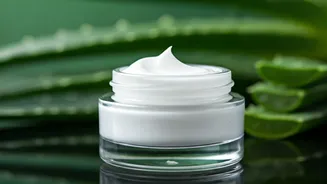What is Azelaic Acid?
Azelaic acid is a naturally occurring dicarboxylic acid found in grains like wheat, rye, and barley. It's also produced by a type of yeast that lives on
normal skin. In skincare, azelaic acid is celebrated for its ability to target a variety of skin concerns. It is not an exfoliant like AHAs or BHAs; instead, it is a multitasking ingredient with anti-inflammatory, antioxidant, and antibacterial properties. These properties make it beneficial for conditions like acne, rosacea, and hyperpigmentation. Unlike some other active ingredients, azelaic acid is generally well-tolerated and can be used by those with sensitive skin. It helps to unclog pores, reduce inflammation, and even out skin tone. It is also a potent antioxidant, protecting the skin from damage caused by free radicals. This versatile acid can be incorporated into your skincare routine to improve overall skin health and appearance.
Repairing Skin Damage
One of azelaic acid's key strengths is its ability to repair damaged skin. It works by reducing inflammation, a primary contributor to skin damage. It calms the skin, reducing redness and irritation often associated with conditions like rosacea and acne. The acid’s anti-inflammatory properties help soothe the skin and promote a healthier barrier function. This means the skin can better protect itself from external aggressors. Moreover, azelaic acid inhibits the production of melanin, the pigment responsible for dark spots and uneven skin tone. By controlling melanin, it helps fade hyperpigmentation, including post-inflammatory marks left behind by acne and sun damage. This leads to a more even complexion. With consistent use, azelaic acid can significantly improve the skin's texture and overall appearance, contributing to a more radiant and healthy glow.
Brightening Your Complexion
Azelaic acid effectively brightens the complexion through multiple mechanisms. Its primary role in brightening is its ability to inhibit tyrosinase, an enzyme crucial for melanin production. By blocking this enzyme, azelaic acid reduces the formation of new dark spots and gradually fades existing ones. This is particularly beneficial for those dealing with post-inflammatory hyperpigmentation (PIH), a common issue after acne breakouts. Azelaic acid also acts as an antioxidant, combating free radicals that can cause skin damage and dullness. By neutralizing these damaging molecules, it protects the skin and helps maintain its natural radiance. Additionally, it promotes cell turnover, helping to shed dull, pigmented skin cells and reveal a brighter, more even complexion. Through these combined effects, azelaic acid can bring about a noticeable improvement in skin clarity, leading to a more vibrant and youthful appearance.
Calming Skin Irritation
Azelaic acid is a champion at calming irritated skin, making it a valuable asset for those with sensitive or reactive skin. Its anti-inflammatory properties are key to this calming effect. It reduces redness, swelling, and itching associated with conditions such as rosacea and eczema. This soothing action provides immediate comfort and helps prevent further irritation. The acid also has antibacterial properties, which can help control the bacteria that contribute to acne and skin inflammation. By addressing the root causes of irritation, azelaic acid can reduce flare-ups and promote a healthier skin environment. Furthermore, azelaic acid is generally well-tolerated, even by sensitive skin types. This makes it a great option for those seeking a gentle yet effective solution to calm and soothe irritated skin. Using it can significantly improve comfort and promote a more balanced complexion.
How to Use Azelaic Acid
Incorporating azelaic acid into your skincare routine is relatively straightforward, but starting slowly is recommended. Begin by introducing a product with a lower concentration of azelaic acid, typically between 10% and 20%. Apply it once or twice daily, after cleansing and before moisturizing. If using a serum, apply a thin layer to your face, avoiding the eye area. If using a cream or gel, follow the product instructions. It is wise to start with a less frequent application (e.g., every other day) to assess your skin's tolerance. Watch for any signs of irritation, such as redness or dryness. If your skin is tolerating it well, you can gradually increase the frequency of use. When used during the day, always follow with a broad-spectrum sunscreen. This will help protect your skin from sun damage and enhance the benefits of azelaic acid. Be patient, as it may take several weeks or months to see significant results. Consulting a dermatologist can provide personalized guidance and help you achieve the best possible outcomes.














